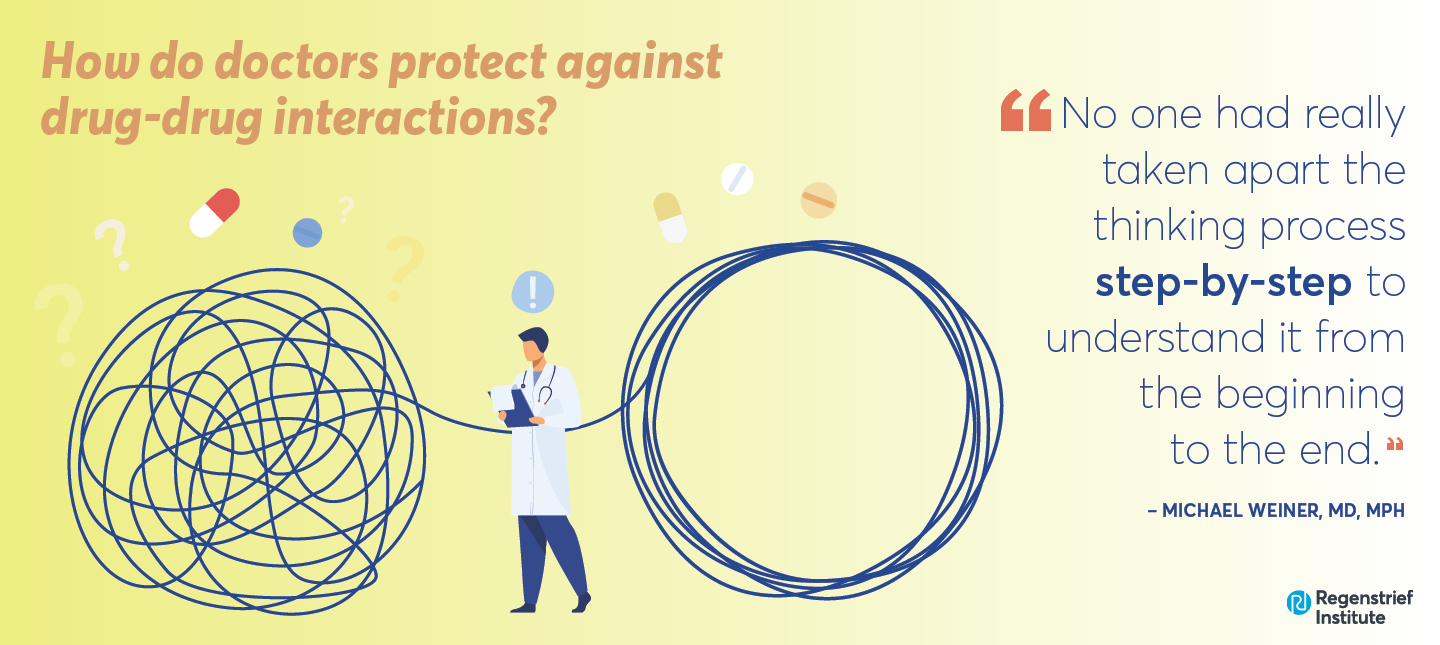Drug-drug interactions causing adverse effects are common and can cause significant patient harm and even death. A new study is one of the first to examine how clinicians become aware of and process information about potential interactions and subsequently make their real-world decisions about prescribing. Based on these findings, the research team makes specific recommendations to aid clinician decision-making to improve patient safety.
“Drug-drug interactions are very common, more common than a lot of people outside the healthcare system expect. In the U.S., these interactions lead to hundreds of thousands of hospitalizations in any given year at an enormous cost,” said study senior author Michael Weiner, M.D., MPH, of U.S. Department of Veterans Affairs, Regenstrief Institute and Indiana University School of Medicine. “Most of these drug interactions are preventable.
“This study was needed because we previously didn’t have a great understanding of how clinicians actually make decisions in assessing these interactions. No one had really taken apart the thinking process step-by-step to understand it from the beginning to the end. There’s a patient, there’s a drug and another drug. There is now a potential interaction. There’s been a decision about how to resolve it following an assessment and then a resolution process. Understanding all this is very important if we are hoping to design improvements to the medical system that enhance patient safety.”
The research team focused on positive cases, where clinicians identified a drug-drug interaction concern and took action to help protect the patient. They analyzed all aspects of clinicians’ decision-making process, especially specific cues they used to assess patients’ clinical risk and identify safer treatment options.
Clinicians become aware of drug-drug interactions in different ways. In addition to their own knowledge and consultations with colleagues, reference books or professional websites, the electronic health record (EHR) is a very common source of drug interaction alerts because all medications would ideally be logged, ordered or tracked. However, if a patient is prescribed drugs in multiple health systems there typically is not integration of their EHR records. Reconciling all their medication information may be a formidable task for physicians, nurse practitioners, pharmacists or other clinicians, all of whom are often operating under rigorous time constraints.
The study identified 19 cognitive cues upon which clinicians rely to detect and make decisions about drug-drug interactions. These cues include:
- information that influenced interpretation of potential severity of drug-drug interaction
- type or degree of side effects or harms
- patient’s expected duration of exposure to interaction
- patient-specific conditions that may increase risk of interaction
- patient’s medical need for the medications
- characteristics of safer medications
Drug-drug interactions can be addressed by investigating alternative treatments that might be better or safer, altering dosage, as well as stopping or not prescribing a specific medication. Companion activities include educating patients about the warning signs of drug-drug interactions and related adverse events.
There may be situations where the risk of the interaction is considered acceptable based on the benefits and risks of the drugs being considered. But in other cases, a preventive strategy can involve either the patient’s clinicians or the patient or both.
With the greater understanding of clinicians’ cognitive processes related to drug-drug interactions in hospital or outpatient settings presented in this study, there is the potential to design and implement EHR system alerts that provide better, more actionable and more timely information to inform clinicians’ decision-making process and ultimately to improve patient safety.
“This was a rewarding study, not only because of its important scientific contributions, but also that clinicians had the opportunity to spend an hour during an interview, describing in detail actions they took to protect patients from harm,” said study lead author Alissa Russ-Jara, PhD, of Purdue University College of Pharmacy and U.S. Department of Veterans Affairs and a Regenstrief Institute affiliated scientist. “By the end of the interview, many clinicians expressed surprise at how much nuance went into their own decision. Their decisions often occur so rapidly, yet involve so much expertise. Ours was the first study to really unpack that for their decisions around drug-drug interactions. We expect our findings can improve the design and usability of drug-drug interaction alerts for clinicians, and so they can more effectively aid patient safety. Our study focused on clinical decision-making, regardless of whether the clinician was warned by an alert or not, so our findings have implications for clinicians, informatics leaders, and patients, and for any EHR system.”
Recommendations for alert design include:
- provide information on expected range of timing of potential drug-drug interaction effects (days, weeks, months or years)
- provide a means for clinicians to review multiple electronic drug-drug interaction reference sources directly from the alert, side-by-side
- leverage data analytics to populate drug-drug interaction alerts with “smart” displays of alternative drugs, that align with three criteria used by clinicians.
- provide recommendations(s) on the alert along with associated patient characteristics (for example, “monitor, if patient indicates willingness and capability of measuring blood pressure daily”)
“Cognitive Task Analysis of Clinicians’ Drug-Drug Interaction Management during Patient Care and Implications for Alert Design” is published in BMJ Open.
Authors and affiliations
Alissa L. Russ-Jara, PhD1-3; Nervana Elkhadragy, PharmD, M.S., PhD2,4; Karen J. Arthur, PharmD5; Julie B. Diiulio, M.S6; Laura G. Militello, M.A.6; Amanda P. Ifeachor, PharmD, MPH5; Peter A. Glassman, MBBS, MSc7,8,9; Alan J. Zillich, PharmD2; Michael Weiner, M.D., MPH1,5,10,11
1Health Services Research and Development Service CIN 13-416, Center for Health Information and Communication, U.S. Department of Veterans Affairs (VA), Veterans Health Administration, Indianapolis, Indiana, USA
2Department of Pharmacy Practice, College of Pharmacy, Purdue University, West Lafayette, Indiana, USA
3Regenstrief Center for Healthcare Engineering, Purdue University, West Lafayette, Indiana, USA
4School of Pharmacy, University of Wyoming, Laramie, Wyoming, USA
5Richard L. Roudebush VA Medical Center, U.S. Department of Veterans Affairs (VA), Veterans Health Administration, Indianapolis, Indiana, USA
6Applied Decision Science, LLC, Dayton, Ohio, USA
7Department of Medicine, David Geffen School of Medicine at UCLA, Los Angeles, California, USA
8Pharmacy Benefits Management Services, Department of Veterans Affairs (VA), Washington DC, USA
9Department of Medicine, VA Greater Los Angeles Healthcare System, Los Angeles, CA, USA
10Center for Health Services Research, Regenstrief Institute, Inc., Indianapolis, Indiana, USA
11Department of Medicine, Indiana University, Indianapolis, Indiana, USA
In addition to the affiliations listed above, Dr. Russ-Jara and Dr. Zillich are Regenstrief Institute affiliate scientists.
This work was supported by the VA Health Services Research and Development Service, Career Development Award 11-214.
About Michael Weiner, M.D., MPH
In addition to his role as a research scientist with the William M. Tierney Center for Health Services Research at Regenstrief Institute, Michael Weiner, M.D., MPH, is a research scientist at the VA Health Service Research and Development Center for Health Information and Communication, Richard L. Roudebush VA Medical Center, and a professor of medicine at Indiana University School of Medicine.
About Regenstrief Institute
Founded in 1969 in Indianapolis, the Regenstrief Institute is a local, national and global leader dedicated to a world where better information empowers people to end disease and realize true health. A key research partner to Indiana University, Regenstrief and its research scientists are responsible for a growing number of major healthcare innovations and studies. Examples range from the development of global health information technology standards that enable the use and interoperability of electronic health records to improving patient-physician communications, to creating models of care that inform clinical practice and improve the lives of patients around the globe.
Sam Regenstrief, a nationally successful entrepreneur from Connersville, Indiana, founded the institute with the goal of making healthcare more efficient and accessible for everyone. His vision continues to guide the institute’s research mission.
About Veteran Health Indiana and CHIC
The Richard L. Roudebush VA Medical Center is the flagship medical center for Veteran Health Indiana, the VA’s healthcare system in central and southern Indiana. The medical center is located in downtown Indianapolis and is collocated with three large community hospitals and the campus of the Indiana University Schools of Medicine and Nursing. The health system has been serving Hoosier Veterans since 1932. As Indiana’s Level 1a, tertiary care Veteran facility, the medical center serves as home base for a system of inpatient and outpatient care locations serving more than 62,000 Veterans.
The VA Health Services Research and Development (HSR&D) Center for Health Information and Communication (CHIC) group is a diverse cadre of researchers based at Roudebush VA Medical Center who work together to transform the healthcare system, both within and outside the VA so every patient receives consistent, high-quality care.
About IU School of Medicine
IU School of Medicine is the largest medical school in the U.S. and is annually ranked among the top medical schools in the nation by U.S. News & World Report. The school offers high-quality medical education, access to leading medical research and rich campus life in nine Indiana cities, including rural and urban locations consistently recognized for livability.
About Purdue University College of Pharmacy
The mission of the Purdue University College of Pharmacy is to advance scientific discovery and development, maximize global health outcomes through patient care and public service, and educate and train students to become leading pharmacists and scientists. The goal is to transform the practice and science of pharmacy to lead advances in human health.










